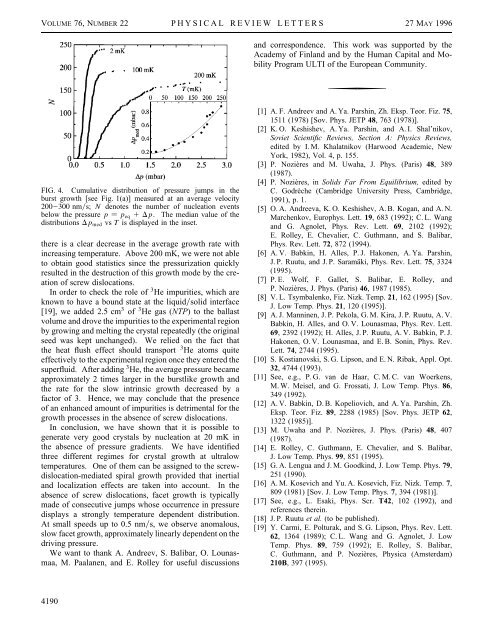PRL76, 4187 - Low Temperature Laboratory
PRL76, 4187 - Low Temperature Laboratory
PRL76, 4187 - Low Temperature Laboratory
Create successful ePaper yourself
Turn your PDF publications into a flip-book with our unique Google optimized e-Paper software.
VOLUME 76, NUMBER 22 PHYSICAL REVIEW LETTERS 27MAY 1996<br />
FIG. 4. Cumulative distribution of pressure jumps in the<br />
burst growth [see Fig. 1(a)] measured at an average velocity<br />
200 300 nms; N denotes the number of nucleation events<br />
below the pressure p peq 1Dp. The median value of the<br />
distributions Dpmed vs T is displayed in the inset.<br />
there is a clear decrease in the average growth rate with<br />
increasing temperature. Above 200 mK, we were not able<br />
to obtain good statistics since the pressurization quickly<br />
resulted in the destruction of this growth mode by the creation<br />
of screw dislocations.<br />
In order to check the role of 3 He impurities, which are<br />
known to have a bound state at the liquidsolid interface<br />
[19], we added 2.5 cm 3 of 3 He gas (NTP) to the ballast<br />
volume and drove the impurities to the experimental region<br />
by growing and melting the crystal repeatedly (the original<br />
seed was kept unchanged). We relied on the fact that<br />
the heat flush effect should transport 3 He atoms quite<br />
effectively to the experimental region once they entered the<br />
superfluid. After adding 3 He, the average pressure became<br />
approximately 2 times larger in the burstlike growth and<br />
the rate for the slow intrinsic growth decreased by a<br />
factor of 3. Hence, we may conclude that the presence<br />
of an enhanced amount of impurities is detrimental for the<br />
growth processes in the absence of screw dislocations.<br />
In conclusion, we have shown that it is possible to<br />
generate very good crystals by nucleation at 20 mK in<br />
the absence of pressure gradients. We have identified<br />
three different regimes for crystal growth at ultralow<br />
temperatures. One of them can be assigned to the screwdislocation-mediated<br />
spiral growth provided that inertial<br />
and localization effects are taken into account. In the<br />
absence of screw dislocations, facet growth is typically<br />
made of consecutive jumps whose occurrence in pressure<br />
displays a strongly temperature dependent distribution.<br />
At small speeds up to 0.5 nms, we observe anomalous,<br />
slow facet growth, approximately linearly dependent on the<br />
driving pressure.<br />
We want to thank A. Andreev, S. Balibar, O. Lounasmaa,<br />
M. Paalanen, and E. Rolley for useful discussions<br />
4190<br />
and correspondence. This work was supported by the<br />
Academy of Finland and by the Human Capital and Mobility<br />
Program ULTI of the European Community.<br />
[1] A. F. Andreev and A. Ya. Parshin, Zh. Eksp. Teor. Fiz. 75,<br />
1511 (1978) [Sov. Phys. JETP 48, 763 (1978)].<br />
[2] K. O. Keshishev, A. Ya. Parshin, and A. I. Shal’nikov,<br />
Soviet Scientific Reviews, Section A: Physics Reviews,<br />
edited by I. M. Khalatnikov (Harwood Academic, New<br />
York, 1982), Vol. 4, p. 155.<br />
[3] P. Nozières and M. Uwaha, J. Phys. (Paris) 48, 389<br />
(1987).<br />
[4] P. Nozières, in Solids Far From Equilibrium, edited by<br />
C. Godrèche (Cambridge University Press, Cambridge,<br />
1991), p. 1.<br />
[5] O. A. Andreeva, K. O. Keshishev, A. B. Kogan, and A. N.<br />
Marchenkov, Europhys. Lett. 19, 683 (1992); C. L. Wang<br />
and G. Agnolet, Phys. Rev. Lett. 69, 2102 (1992);<br />
E. Rolley, E. Chevalier, C. Guthmann, and S. Balibar,<br />
Phys. Rev. Lett. 72, 872 (1994).<br />
[6] A. V. Babkin, H. Alles, P. J. Hakonen, A. Ya. Parshin,<br />
J. P. Ruutu, and J. P. Saramäki, Phys. Rev. Lett. 75, 3324<br />
(1995).<br />
[7] P. E. Wolf, F. Gallet, S. Balibar, E. Rolley, and<br />
P. Nozières, J. Phys. (Paris) 46, 1987 (1985).<br />
[8] V. L. Tsymbalenko, Fiz. Nizk. Temp. 21, 162 (1995) [Sov.<br />
J. <strong>Low</strong> Temp. Phys. 21, 120 (1995)].<br />
[9] A. J. Manninen, J. P. Pekola, G. M. Kira, J. P. Ruutu, A. V.<br />
Babkin, H. Alles, and O. V. Lounasmaa, Phys. Rev. Lett.<br />
69, 2392 (1992); H. Alles, J. P. Ruutu, A. V. Babkin, P. J.<br />
Hakonen, O. V. Lounasmaa, and E. B. Sonin, Phys. Rev.<br />
Lett. 74, 2744 (1995).<br />
[10] S. Kostianovski, S. G. Lipson, and E. N. Ribak, Appl. Opt.<br />
32, 4744 (1993).<br />
[11] See, e.g., P. G. van de Haar, C. M. C. van Woerkens,<br />
M. W. Meisel, and G. Frossati, J. <strong>Low</strong> Temp. Phys. 86,<br />
349 (1992).<br />
[12] A. V. Babkin, D. B. Kopeliovich, and A. Ya. Parshin, Zh.<br />
Eksp. Teor. Fiz. 89, 2288 (1985) [Sov. Phys. JETP 62,<br />
1322 (1985)].<br />
[13] M. Uwaha and P. Nozières, J. Phys. (Paris) 48, 407<br />
(1987).<br />
[14] E. Rolley, C. Guthmann, E. Chevalier, and S. Balibar,<br />
J. <strong>Low</strong> Temp. Phys. 99, 851 (1995).<br />
[15] G. A. Lengua and J. M. Goodkind, J. <strong>Low</strong> Temp. Phys. 79,<br />
251 (1990).<br />
[16] A. M. Kosevich and Yu. A. Kosevich, Fiz. Nizk. Temp. 7,<br />
809 (1981) [Sov. J. <strong>Low</strong> Temp. Phys. 7, 394 (1981)].<br />
[17] See, e.g., L. Esaki, Phys. Scr. T42, 102 (1992), and<br />
references therein.<br />
[18] J. P. Ruutu et al. (to be published).<br />
[19] Y. Carmi, E. Polturak, and S. G. Lipson, Phys. Rev. Lett.<br />
62, 1364 (1989); C. L. Wang and G. Agnolet, J. <strong>Low</strong><br />
Temp. Phys. 89, 759 (1992); E. Rolley, S. Balibar,<br />
C. Guthmann, and P. Nozières, Physica (Amsterdam)<br />
210B, 397 (1995).
















